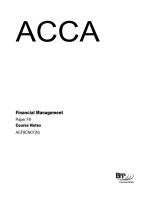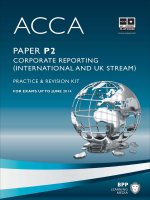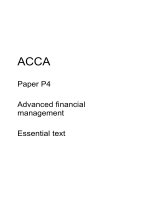ACCA 2017 BPP PASSCARD f6
Bạn đang xem bản rút gọn của tài liệu. Xem và tải ngay bản đầy đủ của tài liệu tại đây (2.84 MB, 177 trang )
ACCA APPROVED
CONTENT PROVIDER
ACCA Passcards
Paper F6
Taxation (UK)
FAs 2015
For exams in September 2016,
December 2016 and March 2017
ACF6PC16.indd 1
20/01/2016 17:20
(000)ACF6PC13_FP_Ricoh.qxp
1/21/2016
3:34 AM
Page i
Fundamentals Paper F6
Taxation FAs 2015
(000)ACF6PC13_FP_Ricoh.qxp
1/21/2016
3:34 AM
First edition 2007, Tenth edition February 2016
ISBN 9781 4727 4453 1
e ISBN 9781 4727 4680 1
British Library Cataloguing-in-Publication Data
A catalogue record for this book is available from the
British Library
Published by
Printed in the United Kingdom
BPP Learning Media Ltd, by RICOH UK Limited
BPP House, Aldine Place, Unit 2
142–144 Uxbridge Road, Wells Place
Merstham
London W12 8AA
www.bpp.com/learningmedia RH1 3LG
Your learning materials, published by BPP Learning
Media Ltd, are printed on paper obtained from traceable
sustainable sources.
Page ii
All rights reserved. No part of this publication may be
reproduced, stored in a retrieval system or transmitted, in
any form or by any means, electronic, mechanical,
photocopying, recording or otherwise, without the prior
written permission of BPP Learning Media.
©
BPP Learning Media Ltd
2016
(000)ACF6PC13_FP_Ricoh.qxp
1/21/2016
3:34 AM
Page iii
Preface
Contents
Welcome to BPP Learning Media's ACCA Passcards for Fundamentals Paper F6 Taxation (UK).
They save you time. Important topics are summarised for you.
They incorporate diagrams to kick start your memory.
They follow the overall structure of the BPP Learning Media Study Texts, but BPP Learning Media's
ACCA Passcards are not just a condensed book. Each card has been separately designed for clear
presentation. Topics are self contained and can be grasped visually.
ACCA Passcards are still just the right size for pockets, briefcases and bags.
ACCA Passcards focus on the exam you will be facing.
Run through the complete set of Passcards as often as you can during your final revision period. The day
before the exam, try to go through the Passcards again! You will then be well on your way to passing your
exams.
Good luck!
Page iii
(000)ACF6PC13_FP_Ricoh.qxp
1/21/2016
3:34 AM
Page iv
Preface
Page
1
1
Introduction to the UK tax system
2
Computing taxable income and the
income tax liability
9
3
Employment income
21
4
Taxable and exempt benefits.
The PAYE system
25
5
Pensions
6
Contents
Page
Partnerships and limited liability
partnerships
63
12
National insurance contributions
67
13
Computing chargeable gains
71
14
Chattels and the principal private residence
exemption
79
33
15
Business reliefs
85
Property income
39
16
Shares and securities
91
7
Computing trading income
43
17
8
Capital allowances
49
Self-assessment and payment of tax by
individuals
95
18
Inheritance tax: scope and transfers
of value
103
Computing taxable total profits
and the corporation tax liability
113
9
Assessable trading income
55
10
Trading losses
59
11
19
(000)ACF6PC13_FP_Ricoh.qxp
1/21/2016
3:34 AM
Page
121
20
Chargeable gains for companies
21
Losses
129
22
Groups
133
Page v
Page v
Page
23
Self-assessment and payment of tax by
companies
137
24
An introduction to VAT
141
25
Further aspects of VAT
151
Contents
(000)ACF6PC13_FP_Ricoh.qxp
1/21/2016
3:34 AM
Notes
Page vi
(001)ACF6PC13_CH01.qxp
1/21/2016
3:34 AM
Page 1
1: Introduction to the UK tax system
Topic List
The overall function and purpose of
taxation in a modern economy
Different types of taxes
Principal sources of revenue law and
practice
Tax avoidance and tax evasion
This chapter contains background knowledge which
underpins the whole of your later studies of taxation.
(001)ACF6PC13_CH01.qxp
1/21/2016
The overall function and purpose
of taxation in a modern economy
3:34 AM
Page 2
Different types
of taxes
Principal sources of
revenue law and practice
Tax avoidance
and tax evasion
Economic factors
Taxation represents a withdrawal from the UK economy. Tax policies can be used to encourage and
discourage certain types of activity.
Encourages
Saving
Charitable donations
Entrepreneurs
Investment in plant and machinery
Social factors
Tax policies can be used to redistribute wealth
Direct taxes – tax only those who have these resources
Indirect taxes – discourage spending
Progressive taxes – target those who can afford to pay
Discourages
Smoking
Alcohol
Motoring
Environmental factors
Taxes may be levied for environmental
reasons
Climate change levy
Landfill tax
(001)ACF6PC13_CH01.qxp
1/21/2016
3:34 AM
The overall function and purpose
of taxation in a modern economy
Direct
taxes
Indirect
taxes
Page 3
Page 3
Different types
of taxes
Principal sources of
revenue law and practice
Tax avoidance
and tax evasion
Income tax
Individuals
Partnerships
Corporation tax
Companies
Capital gains tax
Individuals
Partnerships
Companies (in the form of corporation tax)
Inheritance tax
Individuals
National insurance
Employers
Employees
Self-employed
Value added tax
Businesses (both incorporated and unincorporated)
1: Introduction to the UK tax system
(001)ACF6PC13_CH01.qxp
1/21/2016
The overall function and purpose
of taxation in a modern economy
3:34 AM
Page 4
Different types
of taxes
Principal sources of
revenue law and practice
Tax avoidance
and tax evasion
Structure of the UK Tax system
Treasury
Officers of Revenue and Customs
Crown Prosecution Service
HM Revenue and Customs
Appeals heard by
First Tier Tribunal (most cases)
Upper Tribunal (complex cases)
Sources of revenue law and practice
Law
Statute
Statutory instrument
Practice
Statements of practice
Extra-statutory concessions
Explanatory leaflets
Revenue and Customs Brief
Internal Guidance (HMRC manuals)
Agent Update
(001)ACF6PC13_CH01.qxp
1/21/2016
3:34 AM
European Union
Page 5
Double taxation agreements
States may agree to enact Directives to provide
for common taxation
Prevents income or gains being taxed in more
than one country
Value added tax (VAT) Directives oblige UK to
pass laws in accordance with EU legislation
Income/gain taxed in one country only or credit
given for tax in one country against tax in other
country
Tax provisions which discriminate against EU
freedoms may be ineffective due to treaty direct
effect
Exchange of information
Page 5
Non-discrimination provisions to protect foreign
nationals
Exchange of information
1: Introduction to the UK tax system
(001)ACF6PC13_CH01.qxp
1/21/2016
The overall function and purpose
of taxation in a modern economy
3:34 AM
Page 6
Different types
of taxes
Principal sources of
revenue law and practice
Tax avoidance
and tax evasion
Tax evasion
Tax avoidance
Tax evasion consists of seeking to mislead HMRC
by either:
Tax avoidance includes any legal method of
reducing your tax burden, eg:
Suppressing information, or
Using tax shelters, or
Providing deliberately false information.
Participating in schemes designed to minimise
tax.
Illegal
Legal
(001)ACF6PC13_CH01.qxp
1/21/2016
3:34 AM
Page 7
General Anti-Abuse Rule (GAAR)
HMRC can counteract tax advantages from abusive tax arrangements
Tax arrangements involve obtaining a tax advantage as (one of) their main
purpose(s)
Arrangements are abusive if they cannot be regarded as a reasonable course of
action and result in eg significantly less income, profits or gains being taxable
Tax advantage includes relief or repayment of tax
HMRC may counteract tax advantages arising by eg increasing the taxpayer's
tax liability
Page 7
1: Introduction to the UK tax system
(001)ACF6PC13_CH01.qxp
1/21/2016
3:34 AM
The overall function and purpose
of taxation in a modern economy
Page 8
Different types
of taxes
Principal sources of
revenue law and practice
Tax avoidance
and tax evasion
Concerns whether client is honest with HMRC
Professional judgement of accountant
Must act honestly and objectively
Recommend disclosure to HMRC
If no disclosure, cease to act
Make money laundering report
Avoid 'tipping-off' the client
Inform HMRC but not details of why
(002)ACF6PC13_CH02.qxp
1/21/2016
3:35 AM
Page 9
2: Computing taxable income and
the income tax liability
Topic List
Scope of income tax
Computing taxable income
Chargeable/Exempt income
Deductible interest
Computing income tax
Gift aid
Child benefit income tax charge
Transferable personal allowance
Jointly held property
The computation of income tax is a key exam topic. One
of the 15 mark questions in Section C will focus on
income tax. Income tax will also be tested in Section A
and may also appear in the 10 mark questions in
Section B. This chapter deals with computing taxable
income which draws together all of the taxpayer's
income.You will also see how the income tax liability is
computed on taxable income. We also look at how gift
aid donations are given tax relief, the computation of the
child benefit charge, the transferable personal allowance
between spouses/civil partners and how jointly held
property is taxed.
(002)ACF6PC13_CH02.qxp
Scope of
income tax
1/21/2016
Computing
taxable income
3:35 AM
Chargeable/
Exempt income
Page 10
Deductible
interest
Computing
income tax
Gift aid
An individual who is UK resident is taxable on world-wide income.
Test 1st: Automatically not UK resident
Test 2nd: Automatically UK resident
In UK < 16 days in tax year
In UK > 183 days in tax year
In UK < 46 days in tax year, not resident in
any of three previous tax years
Only home in UK
Works full time overseas throughout tax
year, not in UK > 90 days in tax year
Works full time in UK in tax year
(002)ACF6PC13_CH02.qxp
1/21/2016
3:35 AM
Page 11
Test 3rd: UK ties
Number of ties required
to be UK resident
depends on number of days
spent in UK in tax year
(see Tax Tables)
Close family (spouse or civil partner/minor child)
resident in UK
Home available in UK, used in tax year
Substantive work in UK
In UK > 90 days in either of two previous tax years
Spends more time in UK than anywhere else in tax
year (if previously resident only)
Page 11
2: Computing taxable income and the income tax liability
(002)ACF6PC13_CH02.qxp
Scope of
income tax
1/21/2016
Computing
taxable income
3:35 AM
Chargeable/
Exempt income
Aggregation of income
A basic principle of income tax is the aggregation of
income. All of an individual's income for a tax year is
added up in a personal tax computation as total income.
Net income
Total income minus deductible interest and trade losses.
Adjusted net income
Net income less grossed up gift aid/personal pension
contributions.
Page 12
Deductible
interest
Computing
income tax
Taxable income
Net income minus personal allowance.
Tax liability
The amount of tax charged on income.
Tax payable
The balance of the tax liability still to be paid.
Gift aid
(002)ACF6PC13_CH02.qxp
1/21/2016
3:35 AM
Page 13
Personal allowance
£10,600 for 2015/16
Restrict if adjusted
net income > £100,000
by £1 for each £2 excess
(nil if > £121,200).
Page 13
2: Computing taxable income and the income tax liability
(002)ACF6PC13_CH02.qxp
Scope of
income tax
1/21/2016
Computing
taxable income
3:35 AM
Chargeable/
Exempt income
Page 14
Deductible
interest
Computing
income tax
Gift aid
Types of income
Income taxed at source
The main types of income for individuals are:
Many sorts of investment income are taxed at source:
for every £100 of income, the individual only receives
£80 of interest or £90 of dividends from UK companies.
The taxable income in both cases is £100, but credit is
given for the tax suffered.
Profits of trades, professions and vocations
Income from employment and pensions
Property income
Savings and investment income, including interest
and dividends
Exempt income
Leave exempt income out of
personal tax computations.
Premium bond prizes
Income from Individual Savings Accounts (ISAs)
Returns on National Savings Certificates
This applies to bank and
building society interest.
Tax credits on dividends
can be offset to reduce
a tax bill but are never
repaid to a taxpayer. Tax
credits on other taxed
income can be repaid.
(002)ACF6PC13_CH02.qxp
Scope of
income tax
1/21/2016
Computing
taxable income
3:35 AM
Chargeable/
Exempt income
Page 15
Deductible
interest
Computing
income tax
Gift aid
Deductible interest
Interest paid on a particular type of loan is
deducted from total income to compute net
income.
For purchase of an interest in a partnership, or
For purchase of plant and machinery for
partnership (purchase must be by partner), or
For purchase of plant and machinery for use in
employment (purchase must be by employee)
Page 15
2: Computing taxable income and the income tax liability
(002)ACF6PC13_CH02.qxp
Scope of
income tax
1/21/2016
Computing
taxable income
3:35 AM
Chargeable/
Exempt income
Page 16
Deductible
interest
Computing
income tax
Gift aid
Computing income tax
1
2
3
Total non-savings, savings and dividend income separately
Broadly interest
Deduct deductible interest, losses and the personal allowance
from non-savings income first, then savings income then
dividend income
At 20%, 40% and 45%
Tax non-savings income, then savings income, then dividend
income
At 0%, 20%, 40% and 45%
At 10%, 32.5% and 37.5%
The basic rate limit and higher rate limit
There is only one set of rate bands to cover all
must be increased by the gross amount of
types of income.
any gift aid donation/personal pension
contribution (amount paid × 100/80).
If non-savings income does not exceed the starting rate limit, then the savings income is taxed at the starting
rate 0% up to the starting rate limit: £5,000 for 2015/16.
(002)ACF6PC13_CH02.qxp
Scope of
income tax
1/21/2016
Computing
taxable income
3:35 AM
Page 17
Chargeable/
Exempt income
Deductible
interest
Computing
income tax
Gift aid
Gift aid
Gift aid donations are charitable gifts of money which qualify for tax relief.
Donor must make a gift aid declaration to the charity.
Basic rate
Basic rate tax relief given by treating
donation as net of basic rate tax
Page 17
Higher and additional
rate
Higher and additional rate tax relief
given by increasing limits by grossed
up donation
2: Computing taxable income and the income tax liability
(002)ACF6PC13_CH02.qxp
1/21/2016
3:35 AM
Page 18
Child benefit
income tax charge
Transferable personal
allowance
Child benefit charge
Child benefit is paid to individual who cares for at least one child
Usually paid to mother and exempt from tax
Charge reclaims child benefit received by taxpayer or partner
Adjusted net income
> £50,000 < £60,000
Adjusted net income
>£60,000
Charge is 1% of the child benefit
amount for each £100 of adjusted net
income in excess of £50,000
Charge is full amount of child benefit
received
Jointly held
property









